In the past year, the price of AI models has plummeted a hundredfold! In the same sentence, it cost 10 yuan last year, but now it only costs a few cents. At the same time, there are services such as housekeeping, parenting, psychological counseling, and maintenance These ‘handmade jobs’ are becoming increasingly expensive. Technology is experiencing a crazy deflation, while life is becoming increasingly inflationary. This is not an economic joke, but a reality co created by Jevons and Baumol: as machines become smarter, human labor becomes more expensive.
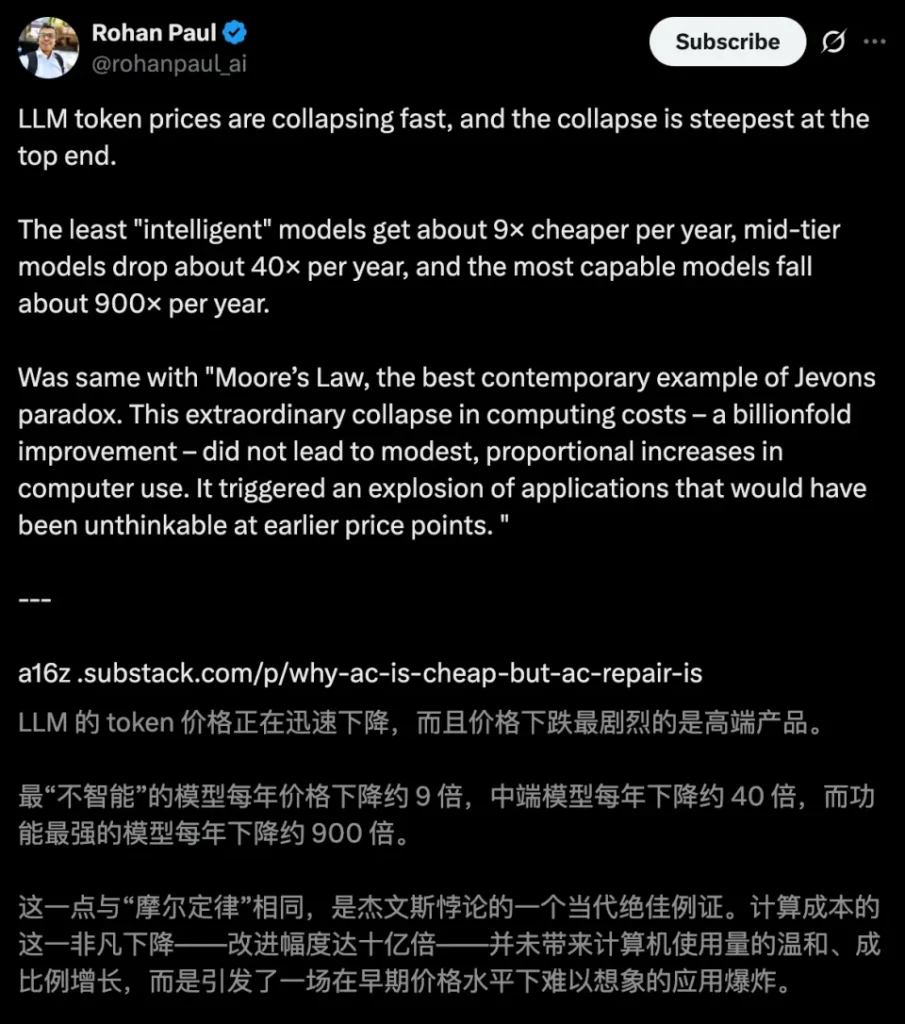
AI prices drop 900 times, even a bottle of mineral water is more expensive than it
The token cost of LLM drops a hundred times every year, and even the highest end models are falling at a rate of 900 times. ”
Last week, this sentence appeared in a post by X.
No illustrations or lengthy arguments, just a cold string of numbers.
But it’s like a nail, fiercely piercing into the nerves of the entire AI industry – the comment section is flooded with a sentence: “Moore’s Law, it’s back
The poster is Rohan Paul, an analyst who has been tracking the cost curve of AI for a long time. He summarized it more directly:
The price of AI is collapsing at a speed unprecedented in any technology in human history.
A few days later, Alex Danco, a researcher at a16z, responded:
Whenever a technology becomes cheaper, human labor becomes more expensive.
Two seemingly independent posts unexpectedly formed a loop.
The price of AI is falling, while the value of humans is rising. The deflation of technology is creating new inflation.
A plummeting AI, inflationary humanity
In the past year, the price of AI models has almost experienced a “free fall” decline.
Researchers have calculated that since the end of 2022, the cost of using GPT-3.5 level models has dropped from approximately $20 per million tokens to $0.07 today – a whopping 280 times cheaper!

There are significant differences in the rate of price collapse among different hierarchical models. The weakest model reduces its price by about 9 times per year, the average by about 40 times, and the strongest by about 900 times.
Another analysis from a16z also suggests that the inference cost of LLM is decreasing at a rate of 10 times per year, comparable to the revival of Moore’s Law.
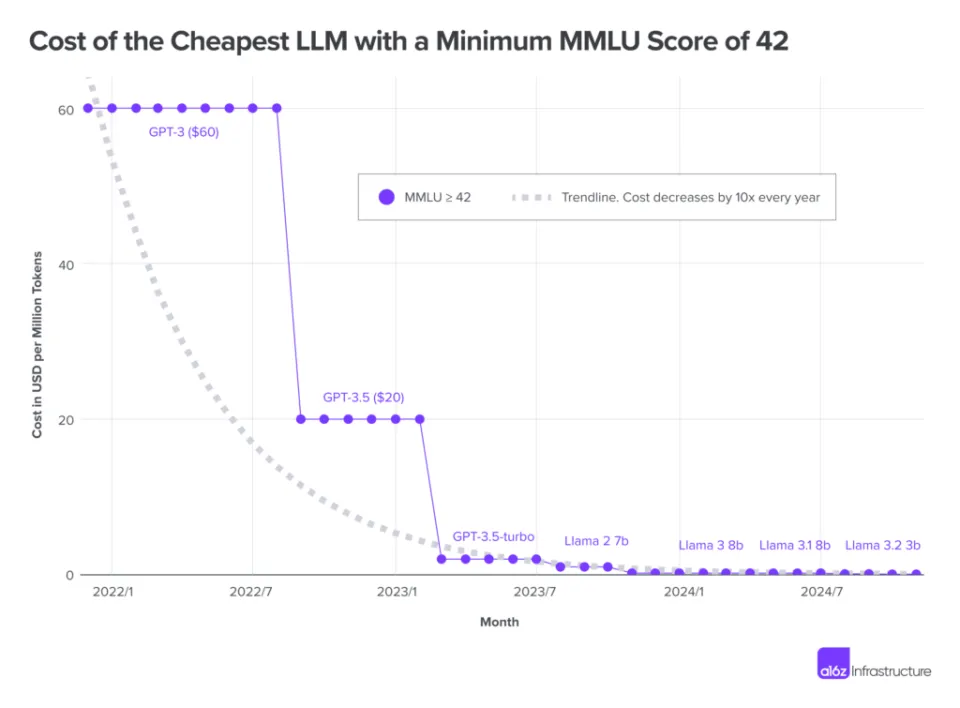
The time collapse curve of AI model prices. Taking the lowest price model that achieves MMLU ≥ 42 points as an example, the cost has dropped from $60 per million tokens at the beginning of 2022 to less than $0.1 per million tokens by 2024.
Previously, generating a novel could cost tens of dollars, but now it can be done for just a few cents.
AI is transforming from luxury goods to ‘tap water’. No matter how much you use, you won’t feel heartbroken, and you may even want to use a little more.
But things are not as simple as imagined. As Rohan Paul said:
Price decline does not represent savings, but rather a new point of consumption explosion.
When model calls become cheap, we start implanting AI everywhere: writing copy, doing translation, coding, cutting videos
The demand for computing power is increasing instead of decreasing, which is actually pushing up energy and hardware prices.
At the same time, labor that cannot be completed by AI, such as household chores, nursing, psychological counseling, and maintenance On the contrary, it is becoming increasingly expensive.
Repairing an air conditioner and hiring a nanny cost far more than training a medium-sized model.
The AI world is experiencing deflation, while the human world is experiencing inflation.

So, a seemingly absurd reality is happening: AI is getting cheaper, but life is getting more expensive.
Behind the collapse of algorithm costs is the restructuring of labor value: the parts that can be replaced by machines quickly depreciate, while the parts that cannot be replaced become new ‘luxury goods’.
The cheaper, the more addictive: AI version of Jevons paradox
In 1865, British economist William Jevons wrote the famous warning:
Don’t think that being more efficient can save fuel – it will only make us burn more.

AI cost plummeting curve. The cheapest model that satisfies MMLU ≥ 42 ranges from $60/million token for GPT-3, $0.5 for GPT-3.5-turbo, and less than $0.1 for Llama 3.2 3b.
At that time, he was referring to the steam engine. But 160 years later, this sentence is repeating itself in AI.
When model prices keep plummeting, we think it’s the ‘era of saving money’.
But the fact is, a decrease in cost will only make people more willing to use it.
Previously, a company had to hold a meeting to approve the purchase of computing power, but now even small and medium-sized enterprises can easily access GPT-4 Turbo with just one click; Previously, a person cautiously asked ten questions in ChatGPT, but now they are running scripts with ten tabs open.
AI is no longer a tool, but a resource for ‘unlimited refills’.
Microsoft CEO Satya Nadella also mentioned in an interview:
The Jevons paradox is back: the more efficient and affordable AI is, the more people cannot do without it.
AI is transforming from “high-end intelligent services” to “new public facilities” – like electricity, water, and Wi Fi, everyone is using them.
This is the so-called ‘AI version of Jevons paradox’: when usage becomes too cheap, humans no longer restrain themselves.
The more you use it, the deeper your dependence.
So we see that enterprises are calling models on a large scale to run A/B tests; Creators use AI for batch generation; The research institution repeatedly fine tunes the model; Developers are using more than ten parallel inference methods.
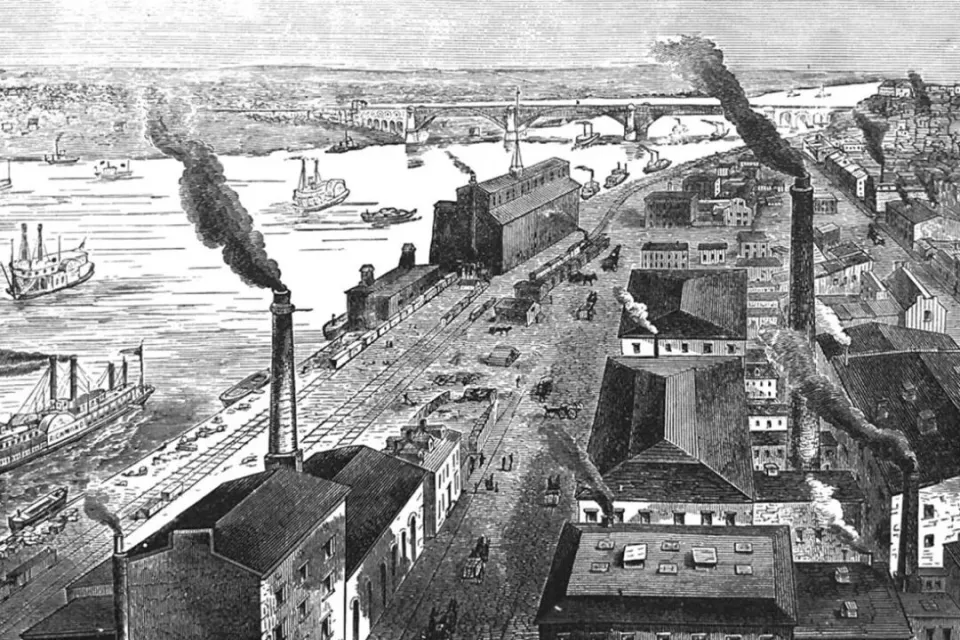
Every price reduction brings about a new round of ‘abuse’. Every efficiency improvement leads to new waste.
And computing power, energy, and chips are also being consumed again in this addictive growth process.
Machines are becoming smarter, while humans have become ‘luxury goods’
As the price of AI continues to fall, a strange contrast is occurring: algorithms are becoming cheaper, but human labor is becoming more expensive.
In the United States, the hourly home service fee has increased to $45; The hourly wage of pipeline repair technicians in the UK even exceeds that of lawyers.
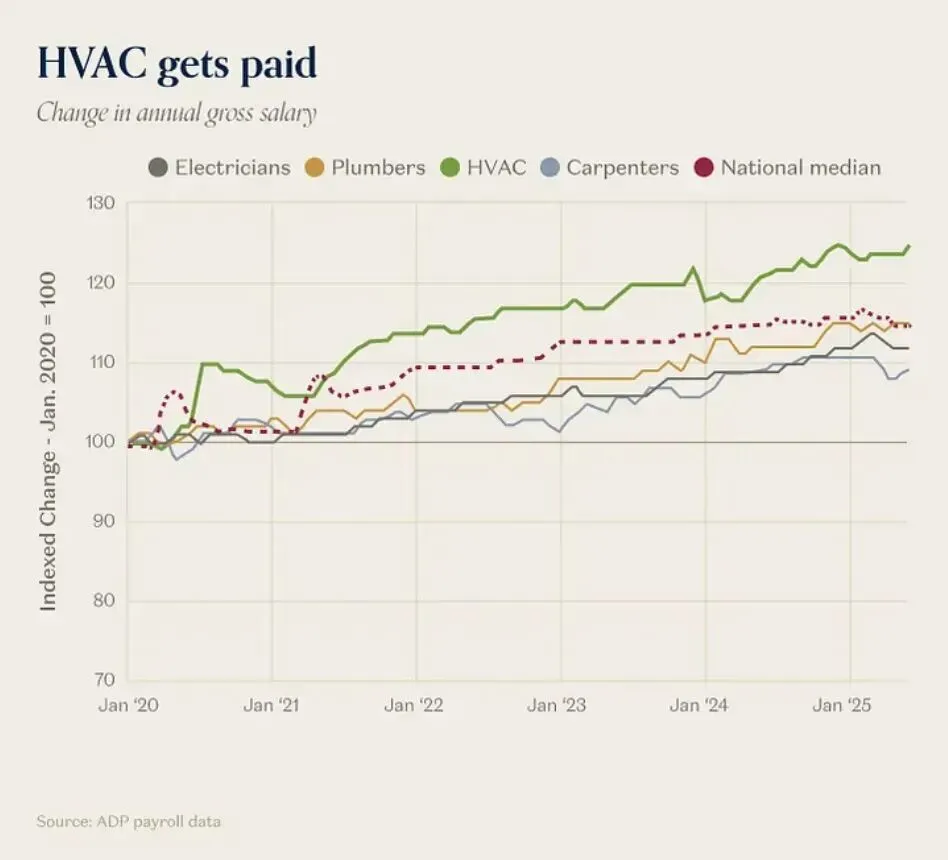
Human inflation in the era of AI deflation: The wage curve of maintenance workers. The annual salary changes of various technical occupations in the United States from 2020 to 2025, with the growth rate of HVAC wages significantly higher than the national median.
A machine learning engineer may only need a few cents to complete reasoning; But a machine repairman costs several hundred yuan to come to the door.
This is not a coincidence, but an inevitability predicted by economists.
In the 1960s, Jevons proposed the Baumol cost disease theory.

He found that industries with higher productivity, such as manufacturing and technology, are more prone to price declines; And those industries that cannot improve efficiency, such as performance, teaching, nursing, and repair, are instead dragged up in price by the overall economic wage level in order to retain people.
In short, the dividend of efficiency will make inefficient work more expensive.
Moving this model to today, it is not difficult to find that AI is a typical high productivity industry, with efficiency increased by a thousand times and costs plummeting by a hundred times;
But those fields that cannot be replaced by AI, such as education, psychological counseling, manual repair, and elderly care, have instead been caught up in the wave of price increases.
As a16z wrote in the analysis:
Technological deflation often creates human inflation.
When computing power turns into tap water, what is truly scarce is only human time, emotions, and presence.
So we see that algorithms are depreciating while personalities are appreciating.
Jobs that can be automated are experiencing a continuous decline in price; Jobs that require ‘human breath’ have become ‘luxury goods’ in the new era.
This may be the most ironic paradox of the AI era – as machines become smarter, being a ‘human’ actually becomes the most expensive.
Technology is decreasing in price, power is concentrating
The price of the model keeps falling, which sounds like a ‘universal benefit’.
Everyone can use it, everyone can access it, and AI seems to have finally become a public resource.
But the reality is exactly the opposite – the cheaper the AI, the more centralized the power.
In recent years, the protagonists of price reduction have never been the open source community, but several giants: OpenAI, Anthropic, Google, Amazon.
While generously lowering API prices, they are also redefining entry points.
The cheaper the model, the more developers cannot do without their ecosystem; The more popular the service, the more they monopolize computing power, data, and algorithm standards.
This is the new pattern of the AI era: prices are falling while prices are rising.
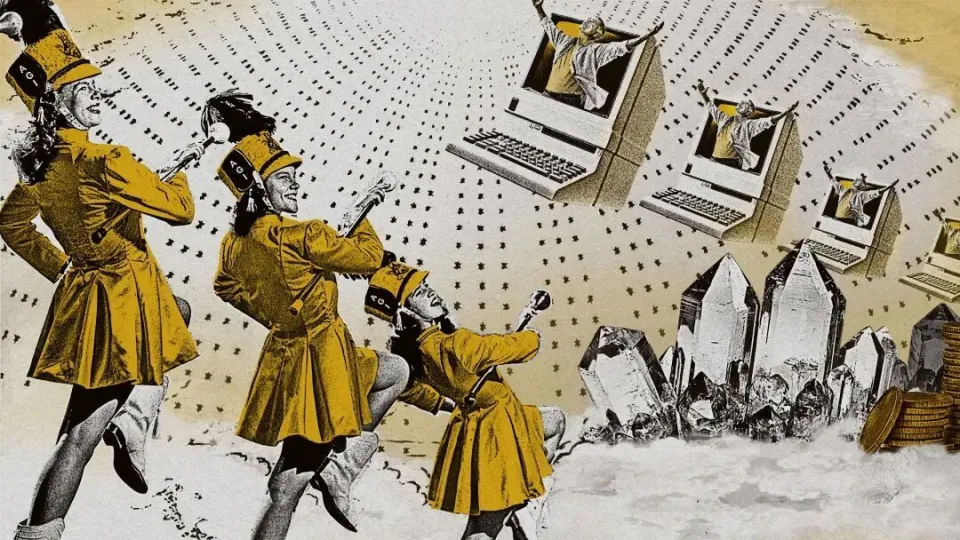
An article from MIT Technology Review states:
When a technology is’ made free ‘, monopolies often achieve invisibility.
The price reduction of AI, which may seem democratic, is actually an acceleration of platformization.
Every time we call the model, we invisibly train the next generation model for large companies.
The collapse of prices has not made the world more equal, but rather allowed us to relinquish more power at a lower cost.
At the same time, a group of ‘interlayer humans’ emerged.
They do not write models, nor will they be temporarily replaced by models, but are sandwiched between giant systems and algorithms: prompt word engineers, data annotators, AI auditors, fine-tuning operators
Their work is brief and repetitive, yet they maintain the operation of the entire AI system; They are labor amplified by AI and people digested by algorithms.
AI has indeed become cheaper, but what is truly expensive is the human time and attention that can dominate AI.
So we see a new paradox: technology in deflation, power in inflation.
The more affordable the model, the more closed the ecology; The more widespread AI becomes, the more singular the center becomes.
Perhaps this is the deepest hidden line of the “AI deflation era” – we thought it was moving towards universal access, but in fact, we are entering a world where costs are approaching zero and power is unified.
What we have experienced is not just a technological price reduction, but a value restructuring.
Models are getting cheaper, algorithms are getting faster, and efficiency is flooding like a tide. What can truly be diluted is actually the ‘definition of human’.
While AI devours repetition and lowers costs, it also increases scarcity in reverse: creativity, emotions, judgment, and companionship, which cannot be calculated by algorithms, have become the new generation of ‘high priced assets’.
The future may not be AI replacing humans, but rather ‘AI pricing humans’.
Some people may be replaced; Some people may be subject to price increases.
Price reduction is the model, price appreciation is the people’s hearts.
Reference materials:
https://x.com/rohanpaul_ai/status/1985671550713147667
https://a16z.substack.com/p/why-ac-is-cheap-but-ac-repair-is










暂无评论内容